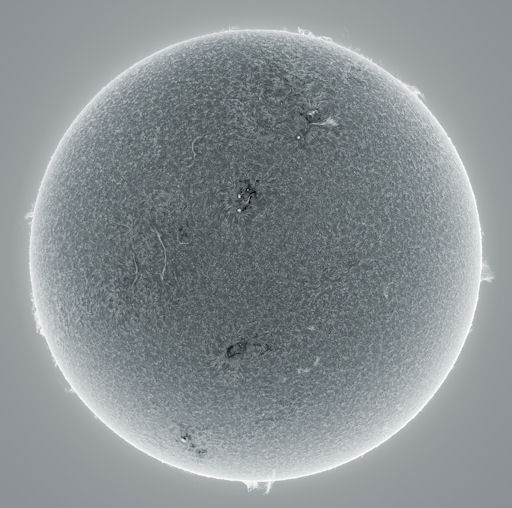ASTEROID SIGHTING: In an age of CCD cameras and high-speed digital recorders, University of Colorado Prof. Richard Keen has done something unusual. He observed an asteroid flyby with nothing but optics and the human eye. On May 29th, newly-discovered asteroid 2012 KT42 passed closer to Earth than a geosynchronous satellite. "Bent over the eyepiece of my 12-inch telescope, I tracked the little space rock for 42 minutes," says Keen. "Along the way it brightened from magnitude 11.5 to 10.5, about a whole magnitude brighter than predicted. Aside from some meteorites I've held in my hands and other meteors flashing though the upper atmosphere, this is the closest astronomical object I've ever seen. According to the NASA ephemeris, 2012 KT42 was just 19158 km from my house when I last saw it--about the same as a plane flight to Australia."
CANVAS FOR A TRANSIT: In only 6 days, Venus will pass in front of the sun, marking the solar disk like the tip of a black-dipped paint brush drawn slowly across the stellar surface. If the transit is indeed like a painting, here is the canvas:
Alan Friedman took the picture from his backyard observatory in Buffalo, NY, on May 28th. "I was getting my ducks in a row for a trip west to observe the transit of Venus, practicing with a new camera and new laptop on the Memorial Day sun," he says. "There was lots of activity to see, including an ejection of plasma from active region 1492."
"What treats will the sun put out when Venus pays a visit next week?" Friedman wonders. Stay tuned.
more images: from Sergio Castillo of Inglewood, California; from Rijk-Jan Koppejan of Middelburg, the Netherlands; from Randy Shivak of Anthem, AZ; from Andre van der Hoeven of HI-Ambacht, the Netherlands; from Dennis Cumberland of Fort St. James B.C.

![]()
Solar wind
speed: 410.7 km/sec
density: 6.5 protons/cm3
explanation | more data
Updated: Today at 1646 UT
![]()
X-ray Solar Flares
6-hr max: B6 0957 UT May30
24-hr: C1 0852 UT May30
explanation | more data
Updated: Today at: 1600 UT
![]()
![]()
![]()
Daily Sun: 30 May 12
![]()
![]()
None of these sunspots is actively flaring. Solar activity is low. Credit: SDO/HMI
![]()
![]()
![]()
Sunspot number: 73
What is the sunspot number?
Updated 29 May 2012
Spotless Days
Current Stretch: 0 days
2012 total: 0 days (0%)
2011 total: 2 days (<1%)
2010 total: 51 days (14%)
2009 total: 260 days (71%)
Since 2004: 821 days
Typical Solar Min: 486 days
Updated 29 May 2012
The Radio Sun
10.7 cm flux: 106 sfu
explanation | more data
Updated 29 May 2012
![]()
![]()
![]()
Current Auroral Oval:
![]()
Switch to: Europe, USA, New Zealand, Antarctica
Credit: NOAA/POES
![]()
![]()
![]()
Planetary K-index
Now: Kp= 2 quiet
24-hr max: Kp= 2 quiet
explanation | more data
![]()
Interplanetary Mag. Field
Btotal: 7.0 nT
Bz: 0.1 nT south
explanation | more data
Updated: Today at 1647 UT
![]()
![]()
![]()
Coronal Holes: 30 May 12
![]()
![]()
A large coronal hole is emerging over the sun's eastern limb. Solar wind flowing from the opening should reach Earth on June 6-7. Credit: SDO/AIA.





